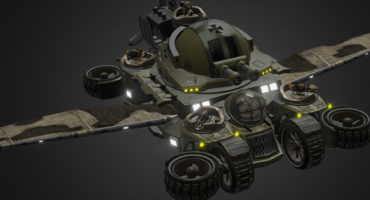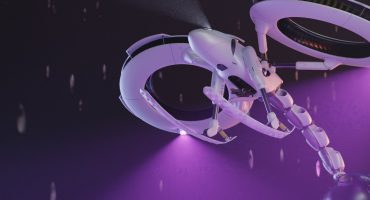In Art Spotlight, we invite Sketchfab artists to talk about one of their designs.
Hi guys, My name is Hong Zhi Hao, or Hao for short. I work in a small studio in Singapore, working on 3D assets for games. My main focus is in low poly modelling, and I like to create characters. If you guys checked out my gallery you would have noticed all my personal work are fan art. Reason for this is I wasn’t always an artist – I was in a totally different industry. I had a lot of interest in video games, animation and comics, so I started doodling characters from games and comics I liked and learning as I went along. I saw an opportunity to switch industry and grabbed on to it, taking up courses in digital art, such as illustration and 3d modeling. In a way, I feel that it was working on fan art that fueled my passion in the CG industry. The key is to have fun, and I have fun doing it!
My process in creating any piece of art is to first conceive an idea. The idea will usually come when I am watching a show, playing a game, reading a book, having a conversation. Ideas come from almost everywhere actually. In this case it was the train of thought beginning from Valentine’s Day, which lead me to think of love stories, I merged that with my interest in animation and I thought of Disney animation, This particular scene in Disney’s Tangled left much impression on me so I decided to create my own rendition of it.
References. Find lots of it. I am not sure if I am allowed to show screenshots of Tangled here. But I collected a lot of references for the characters and props. Shown here are just some of the references I found on the internet.

I start to build the characters first. Being a professional 3D artist means that I have an extensive library of base mesh, I made use of a base mesh I have that most closely resembled the proportions I want in this piece of work, and start tweaking the mesh from there to create my first character
I do not intend to create the models looking exactly the same as the ones from the movie, I prefer to inject a little bit of my own style into the models
Flynn is a pretty straight forward modelling and texturing process.

Rapunzel is at least 3 times more complex, she has her braided hair, flowers, skirt and embroidering on her clothes.
At this point I have to decide on how I want to present my characters. I have a few ideas on what facial expressions I want for my characters, so I modeled in the topology that allows for that.
I modeled Rapunzel’s body parts separately, the hair on its own, head, hands and feet, and clothing on their own as well. I do this because it allows me to completely focus on particular areas finish them before I move on to other body parts.
After modeling the parts separately, I UV unwrapped them, and begin to texture the parts one by one. I go for soft gradual tones rather than strong contrasty ones. Again I go back to my references.
Screenshots from the viewport:

Texturing is a time consuming process, and luckily 3Ds Max allows painting on the models via the viewport canvas tool. I use it to block in the base colors and then apply details on photoshop. It is more convenient to access the viewport canvas directly to fix any errors in texturing than having to go back to photoshop to do so. I usually go back and forth between photoshop and 3Ds max’s viewport canvas tool to get my texturing done.
I modeled the flowers separately, textured them, and attached them to the hair one and a time, making sure they look evenly spaced and not too repetitive.
Finally, I combined the meshes into one single mesh and baked all the textures to one single texture map. I kept separated the mesh that require transparency and used a different piece of texture map for those.

Time for the boat!
I import my character mesh into the same scene as the boat to use as scale reference

Next I created simple skeletons for the characters, nothing too complicated, except for the face, I wanted them to have a certain expression so I focused a bit more on the face. The reason I chose to rig and pose the characters’ expression rather than just straight out modeling the expression out is because of symmetry in terms of modeling, UV and texturing. Also, I have yet to decide on what expressions I wanted so with rigging, I could effectively test out the poses and expressions.
After the simple rigging process is done, I posed the character accordingly, and at the same time, fix any skin weighting issues as needed.


I then moved on the to miscellaneous items, mainly Pascal, and the lanterns. I created two variations of the lanterns and scale their axis to create more variety of different looking lanterns. I proceeded to duplicate dozens of it to fill up the environment.
After this,I put all the characters and props in the same scene, and adjusted their positions accordingly.
Next, I created a large plane for the water.
I used a little trick for the reflection on the water. I duplicated everything that should show as reflection on the water and mirrored them along the appropriate axis.


Next I added lights to the scene in 3ds max. The purpose of this is so I could do a bit of light baking. I need to determine the light sources and the kind of light I want to use. In this case, a few point lights will do, the main light source will be from the lanterns, which should have a warm orangey glow. The ambient should be reflection from the water, I made this light slightly weaker and blue-ish in color, another light source is the lantern from the boat. With that in mind I bake in the light source into the textures. I usually apply the layer of light map onto the original texture map using the soft light blend mode in Photoshop. I think it adds a nice subtle tint that I am looking for. Feel free to try other blending modes as well if you are looking to achieve different effects.

Finally I created the globe that forms the sky surrounding the scene. I did not spend a lot of effort detailing this because I just needed the sky to form a contrast to the subjects of this scene.
Now on to Sketchfab.
I simply make sure the relevant mesh is connected to the appropriate texture map. I applied the same lanterns texture map to the emission settings and have it glow.
The water plane does not have any UVs and texture map assigned since I plan to use Sketchfab’s native material settings for it. I turned the transparency settings and color settings accordingly so the reflected mesh shows through enough to to be seen like it was reflection on water.
Lastly, I tweaked the bloom settings on the post processing filters to give the scene a softer, warmer glow.
Here is the final result on Sketchfab:
Sketchfab has been awesome for my 3D portfolio so far. Imagine modeling a character or asset for work and presenting it to your team or to your client. Instead of rendering out the respective views or a turnaround video, and having to add in notes to explain design decisions, simply upload the model on sketchfab and throw in your notes as annotations, send your team or clients the URL and let them have fun with it! It has speedy load times and plays without issues on mobile. This way I can show my friends and potential clients my 3D work even on the go!
That’s all for now, for more of my work, feel free to check out my Sketchfab Gallery. I also have a Facebook Art Page where I update with my 2D illustrations as well. Finally There is my Deviant Art page where I accept both 2D and 3D commissions as well. Do feel free to follow me for more updates!
A final shout out to Sketchfab and all my (tens of) followers, thank you Sketchfab for providing me with this avenue to share my process. Would gladly do so again if the occasion allows!

Thanks Hao!
Thanks for taking us along the creation process of this beautiful scene, and for sharing your transparency trick with us!


